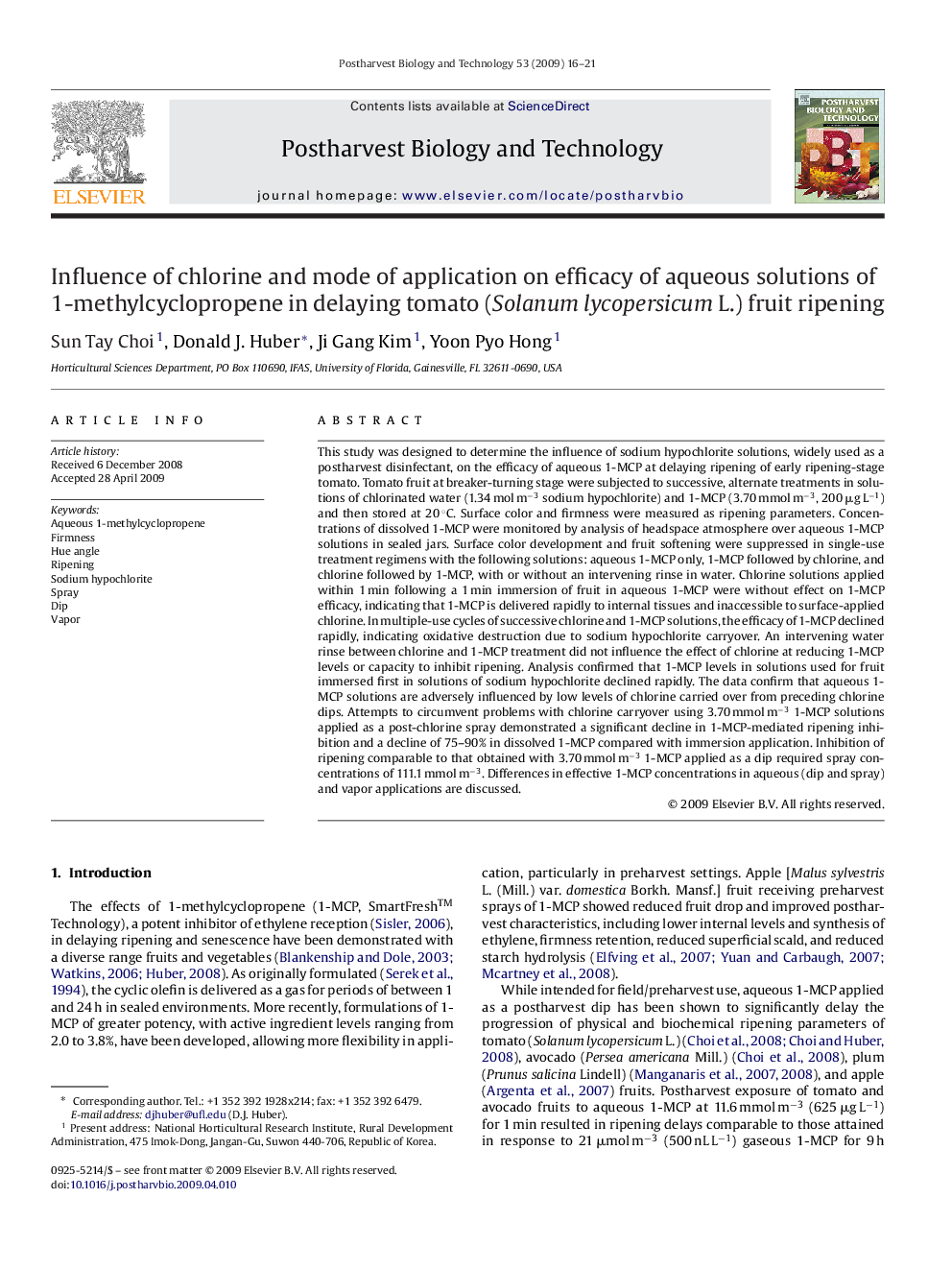| کد مقاله | کد نشریه | سال انتشار | مقاله انگلیسی | نسخه تمام متن |
|---|---|---|---|---|
| 4519350 | 1625032 | 2009 | 6 صفحه PDF | دانلود رایگان |
عنوان انگلیسی مقاله ISI
Influence of chlorine and mode of application on efficacy of aqueous solutions of 1-methylcyclopropene in delaying tomato (Solanum lycopersicum L.) fruit ripening
دانلود مقاله + سفارش ترجمه
دانلود مقاله ISI انگلیسی
رایگان برای ایرانیان
کلمات کلیدی
موضوعات مرتبط
علوم زیستی و بیوفناوری
علوم کشاورزی و بیولوژیک
علوم زراعت و اصلاح نباتات
پیش نمایش صفحه اول مقاله

چکیده انگلیسی
This study was designed to determine the influence of sodium hypochlorite solutions, widely used as a postharvest disinfectant, on the efficacy of aqueous 1-MCP at delaying ripening of early ripening-stage tomato. Tomato fruit at breaker-turning stage were subjected to successive, alternate treatments in solutions of chlorinated water (1.34 mol mâ3 sodium hypochlorite) and 1-MCP (3.70 mmol mâ3, 200 μg Lâ1) and then stored at 20 °C. Surface color and firmness were measured as ripening parameters. Concentrations of dissolved 1-MCP were monitored by analysis of headspace atmosphere over aqueous 1-MCP solutions in sealed jars. Surface color development and fruit softening were suppressed in single-use treatment regimens with the following solutions: aqueous 1-MCP only, 1-MCP followed by chlorine, and chlorine followed by 1-MCP, with or without an intervening rinse in water. Chlorine solutions applied within 1 min following a 1 min immersion of fruit in aqueous 1-MCP were without effect on 1-MCP efficacy, indicating that 1-MCP is delivered rapidly to internal tissues and inaccessible to surface-applied chlorine. In multiple-use cycles of successive chlorine and 1-MCP solutions, the efficacy of 1-MCP declined rapidly, indicating oxidative destruction due to sodium hypochlorite carryover. An intervening water rinse between chlorine and 1-MCP treatment did not influence the effect of chlorine at reducing 1-MCP levels or capacity to inhibit ripening. Analysis confirmed that 1-MCP levels in solutions used for fruit immersed first in solutions of sodium hypochlorite declined rapidly. The data confirm that aqueous 1-MCP solutions are adversely influenced by low levels of chlorine carried over from preceding chlorine dips. Attempts to circumvent problems with chlorine carryover using 3.70 mmol mâ3 1-MCP solutions applied as a post-chlorine spray demonstrated a significant decline in 1-MCP-mediated ripening inhibition and a decline of 75-90% in dissolved 1-MCP compared with immersion application. Inhibition of ripening comparable to that obtained with 3.70 mmol mâ3 1-MCP applied as a dip required spray concentrations of 111.1 mmol mâ3. Differences in effective 1-MCP concentrations in aqueous (dip and spray) and vapor applications are discussed.
ناشر
Database: Elsevier - ScienceDirect (ساینس دایرکت)
Journal: Postharvest Biology and Technology - Volume 53, Issues 1â2, JulyâAugust 2009, Pages 16-21
Journal: Postharvest Biology and Technology - Volume 53, Issues 1â2, JulyâAugust 2009, Pages 16-21
نویسندگان
Sun Tay Choi, Donald J. Huber, Ji Gang Kim, Yoon Pyo Hong,